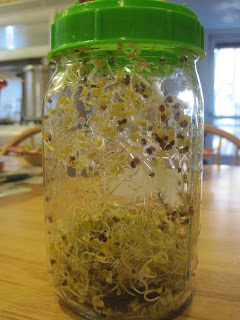Professional chefs and serious gardeners might remind those of us who usually purchase pre-cut, bagged produce that broccoli florets don’t actually grow straight out of the ground. No, they actually occur in clusters along a thick stalk that can grow to be three feet tall. And go figure, broccoli has lots of leaves, too!
In the event that one does buy a bunch of broccoli from the store and prepares it in the usual sort of way, a question arises: What to do with all those stalks? A) Garbage disposal. Be careful to cut them up first. B) Trash can. Don’t risk clogging the disposal. C) Eat them, silly! The stalk is just as tasty and good for you as its more popular younger sister, the floret.
I first considered broccoli stalks when I noticed that they were an ingredient in a bagged coleslaw product from the refrigerated shelf in the produce section. Just like florets, the shredded stalks were delicious with ranch dressing. Then one day I wanted to make broccoli cheese soup, but all I had were the thick stalks hanging out in the back of the veggie drawer in the fridge. So I thought, why not? A few leaves got thrown into the pot along with the stalks. And guess what - the soup was delicious! I’m now fairly certain that both canned broccoli soup and broccoli soup served in restaurants are, in all likelihood, made from stalks, too. Try this recipe and see if you don’t find yourself saving the stalks from the disposal from now on.
I'll start off by explaining how to tackle the stalks, then list the ingredients and steps below. Note: an immersion blender is really what makes this recipe so fast and easy to make, but if you don't have one a blender or food processor will also work.
Broccoli prep: Wash and trim off the lower 1-2 inches from the broccoli stalks. (As you make the cut, you can feel it if you're still in tough stalk territory.) Using a sharp vegetable peeler or knife, cut off the thick, somewhat waxy exterior of the stalk. Make sure to get all of it - the outer part does not cook well and if you skimp here, as I occasionally do for speed, you'll pay for it later with little strings that you'll be picking out of your teeth as you eat the soup! Chop the stalks into 1/2 inch pieces. This whole part can be done ahead of time and either refrigerate or freeze the chopped stalks.
Broccoli Stalk Soup
Serves 4-6
Difficulty Level: Easy
45 minutes, including broccoli stalk prep
Freezes well
Ingredients:
3 or more stalks of broccoli, trimmed, peeled and diced (If you have twice that amount, use them all, but you may need to adjust the liquid and seasoning a bit near the end.)
4 smallish potatoes (organic)
1 medium onion
1 T butter
1 T olive oil
1 T flour
2 cups milk (unsweetened soymilk can be a substitute)
1-1/2 cups shredded sharp cheddar cheese
salt & pepper to taste
Prep broccoli stalks.
Scrub the potatoes, skins on, and microwave for 3 minutes on each side or until cooked through. Once they are cool enough to handle, cut into largish pieces and set aside.
Chop the onion.
Heat butter and olive oil in a large pot on medium heat. Add the onion and saute for a few minutes or until translucent.
Sprinkle the flour into the pot and cook for 1 minute, stirring.
Whisk in 2 cups of water and bring to a boil.
Add the milk and return to almost boiling.
Add the broccoli. Simmer vegetables in the liquid with lid on, for about 10 minutes or until completely tender. Test the broccoli to be sure!- Stir in the potatoes and cheese. Add salt and pepper to taste.
Puree with a handheld immersion blender (or pour into the food processor, then return to the pot - much messier to be sure).
Wait for the applause!

While I'm feeling cheesy, here's one more recipe. As someone who was formerly addicted to Kraft macaroni and cheese (seriously, I would stand at the stove and eat the entire contents of the pot before I could get it to the table!), I can truthfully say that this recipe is good enough to pass muster. Kudos to the vegetarian goddess Nava Atlas for this recipe.
Mahhhvelous Mac & Cheese
Serves 1-4
Difficulty Level: Super Easy
15 minutes or less
12 oz package of elbow pasta
1 package silken tofu (the kind that doesn't need refrigeration)
2 T butter (oh yeah, the real stuff)
1-1/2 cups cheddar cheese
salt to taste
Cook pasta according to package directions.
Use a miniprep blender, immersion blender, or electric beater to blend tofu until smooth.
Transfer tofu to a medium pot, then add cheese and butter.Heat on medium heat until cheese melts, stirring frequently.
Stir pasta into cheese mixture and get comfortable standing in front of the stove as you eat it all from the pot.
Leftovers tip: To reheat, add a little milk first.











